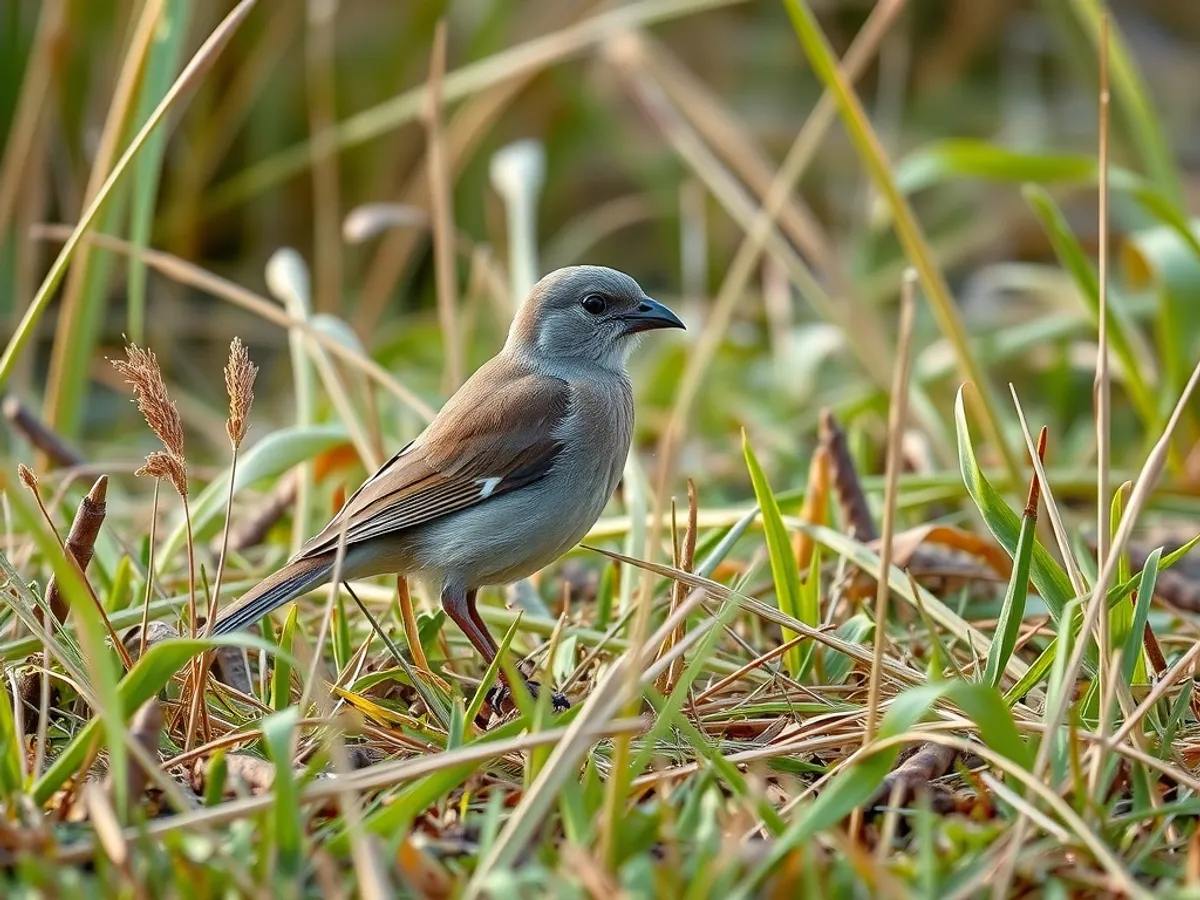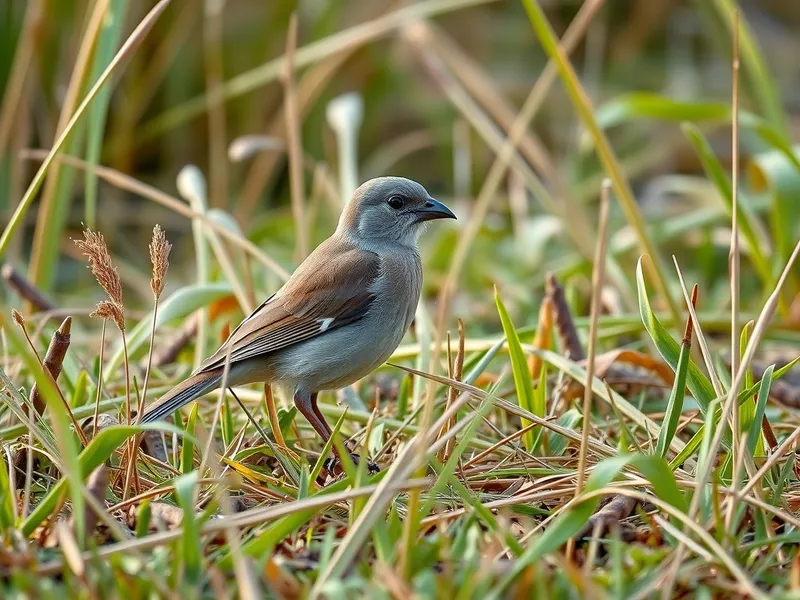
Common Waxbill
Estrilda astrild

Meet the Common Waxbill
The Common Waxbill is a small, sociable finch recognized for its slender body, pointed red bill, and distinct black eye-stripe. Native to sub-Saharan Africa, this bird has been introduced to many parts of the world, including Europe and islands in the Atlantic and Indian Oceans. It prefers grasslands, reedbeds, and open country near water, often forming large flocks outside the breeding season. The Common Waxbill feeds mainly on grass seeds, but it also consumes small insects, especially during the breeding period. Its cheerful, twittering calls and adaptability make it a familiar sight wherever suitable habitat exists.
Classification
Bird
Habitat
Grassland and wetlands
Diet
Herbivore
Lifespan
3-5 years
Conservation
Least Concern
Weight
7-10 grams
📖Fascinating Facts
Distinctive Appearance
The Common Waxbill sports a vivid red bill and a bold black eye-stripe, which stand out against its greyish-brown plumage.
Seed Specialist
Its diet consists mainly of grass seeds, making it an important seed disperser in its ecosystem.
Global Invader
Originally from Africa, the Common Waxbill has established wild populations in Europe, South America, and several islands due to escapes and introductions.
📋Detailed Description
The Common Waxbill (Estrilda astrild) is a diminutive estrildid finch, typically measuring 11–13 cm in length and weighing 7–10 grams. Its plumage is predominantly grey-brown with fine, wavy barring across the flanks, and a distinctive crimson stripe running from the lores through the eye, giving rise to its 'waxbill' moniker. The bill itself is short, conical, and bright red, perfectly adapted for seed consumption. The underparts are paler, often washed with pinkish tones, especially in males. Both sexes are similar in appearance, though males may exhibit slightly more intense coloration. Juveniles are duller, lacking the full intensity of the red facial stripe and bill. The tail is short and rounded, and the wings are pointed, facilitating agile flight. The species is highly gregarious, often forming flocks of dozens to hundreds outside the breeding season. Their vocalizations are soft, high-pitched twitterings and trills, used for communication within flocks. The Common Waxbill is an agile forager, often seen clinging to grass stems or foraging on the ground. Its adaptability to a wide range of open habitats, including anthropogenic landscapes, has enabled it to thrive both within its native range and in introduced populations.
💡 Did you know?
The Common Waxbill's name comes from the waxy, bright red appearance of its beak.
🔬Research & Sources
Wikipedia Summary
The common waxbill, also known as the St Helena waxbill, is a small passerine bird belonging to the estrildid finch family. It is native to sub-Saharan Africa but has been introduced to many other regions of the world and now has an estimated global extent of occurrence of 10,000,000 km2. It is popular and easy to keep in captivity.
Last Modified: 4/30/2025
🎭Behavior & Social Structure
Common Waxbills are diurnal and highly social, spending much of their day foraging in flocks. They exhibit coordinated flock movements, often flying in tight, undulating groups between feeding sites. Foraging is primarily on or near the ground, where they deftly extract seeds from grasses using their specialized bill. During the breeding season, pairs may separate from flocks to establish territories, but outside this period, communal roosting and feeding are the norm. Social interactions include mutual preening, allopreening, and communal dust-bathing. Their alarm calls are sharp and metallic, alerting flock members to predators such as shrikes or raptors. Waxbills are known to bathe frequently in shallow water and are agile climbers among reeds and grasses. They may also exhibit 'anting' behavior, using ants to remove parasites from their plumage.
👶Reproduction & Life Cycle
Breeding can occur year-round in equatorial regions, but is often timed to coincide with the rainy season when food is abundant. Courtship involves males performing a 'seed-offering' display, presenting a grass seed to the female while singing and bobbing. Nests are dome-shaped structures woven from grass stems and lined with feathers, typically built low in dense vegetation or among reeds. Clutch size ranges from 4 to 7 white eggs, with both parents sharing incubation duties for about 11–13 days. After hatching, both parents feed the chicks a diet rich in small insects and regurgitated seeds. Fledging occurs at 17–21 days, but young may remain dependent on parents for a further week. Multiple broods per year are common in favorable conditions.
🛡️Adaptations & Survival
The Common Waxbill's conical, robust bill is a key adaptation for husking small, hard grass seeds, its primary food source. Its cryptic coloration provides camouflage among grasses, while the red facial stripe may play a role in intraspecific recognition. Behavioral flexibility allows it to exploit a range of habitats, including disturbed or urban areas. The species' high reproductive rate and ability to breed opportunistically in response to rainfall contribute to its success. Social flocking reduces predation risk and increases foraging efficiency. Its ability to utilize both seeds and small invertebrates, especially during chick-rearing, allows it to meet varying nutritional demands.
🎨Cultural Significance
The Common Waxbill is a popular cage bird due to its attractive plumage, gentle disposition, and ease of care, especially in Europe and Asia. In some cultures, it symbolizes sociability and adaptability. There are no significant roles in mythology or folklore, but it is occasionally referenced in local art and aviculture literature. Its presence in gardens and parks is often appreciated for its lively behavior and soft calls.
🔬Recent Research & Discoveries
Recent studies have focused on the species' rapid colonization of new habitats, particularly in Macaronesia, southern Europe, and Indian Ocean islands, providing insights into invasion biology and adaptation. Genetic analyses reveal low differentiation among introduced populations, suggesting multiple introductions and high gene flow. Research on vocalizations has highlighted complex social communication and dialect formation in isolated populations. Studies on diet flexibility and breeding phenology have informed understanding of how climate and habitat changes affect reproductive success. The species is also used as a model in studies of estrildid social structure and cooperative breeding.
🎥Wildlife Videos

Benin: On the Trail of a Rare Bird | Global 3000
Researchers estimate that there are between eight and 30 million animal species that have not yet been discovered. But many are ...
DW News

Djuma: Blue Waxbills - 07:58 - 12/20/20
This camera watches over Gowrie dam on Djuma Game Reserve, in the Sabi Sand Wildtuin, South Africa. In fact this is the oldest ...
Djuma Cam

Beautiful TINY cute Bird "Blue Waxbills: Delicate Beauties of the Grasslands"
The Blue Waxbill (Uraeginthus angolensis), also known as the Blue-breasted Cordon-bleu, is a small and beautifully colored bird ...
Cute Animals

Djuma: Blue Waxbills - 09:00 - 09/11/21
This camera watches over Gowrie dam on Djuma Game Reserve, in the Sabi Sand Wildtuin, South Africa. In fact this is the oldest ...
Djuma Cam

Djuma: Blue Waxbills - 08:31 - 08/09/21
This camera watches over Gowrie dam on Djuma Game Reserve, in the Sabi Sand Wildtuin, South Africa. In fact this is the oldest ...
Djuma Cam

Just peaceful birds, spring in the Aviary
Mostly just video of the birds doing what they do in the aviary. Lots of birds. Almost all of my birds.
Echo's Aviary
🌍Habitat Information
The Common Waxbill typically inhabits Grassland and wetlands environments. Common Waxbills have adapted to their environments with specialized features and behaviors.
Primary Habitat:
Grassland and wetlands
More detailed habitat information will be available soon.
🛡️Conservation Status
The Common Waxbill is currently classified as Least Concern. Conservation efforts are crucial for preserving this species for future generations.
Common Threats:
- 🏠Habitat loss and fragmentation
- 🌡️Climate change impacts
- 🎯Hunting and poaching
- 🏭Human-wildlife conflict
⚠️Threats & Conservation Challenges
Currently classified as Least Concern by the IUCN, the Common Waxbill faces few significant threats at a global scale. Its adaptability to human-modified landscapes and generalist diet buffer it against habitat loss. However, localized threats include habitat degradation from intensive agriculture, pesticide use (which may reduce insect prey for chicks), and predation by introduced mammals and birds. In some introduced ranges, competition with native granivorous birds has been noted. Despite widespread trapping for the cage-bird trade, wild populations remain robust and stable, with some evidence of ongoing range expansion.
🔬Scientific Classification
Scientific Name
Estrilda astrild
Classification Hierarchy
🔍 About Taxonomic Classification
Taxonomic classification is a hierarchical system used by scientists to classify and organize living organisms based on shared characteristics and evolutionary relationships.
The system moves from broad categories (Kingdom) to increasingly specific ones, with each animal's scientific name typically consisting of its Genus and species.
📝Community Notes
Share your observations and insights about the Common Waxbill with our community of wildlife enthusiasts.
Join Our Community
Sign in to share your observations and connect with fellow wildlife enthusiasts.
Sign In to ContributeNo community notes yet
Be the first to share your observations about the Common Waxbill!
Explore Common Waxbill
Select a tab above to learn more about this amazing animal.
📸Photo Gallery
No photos available for this animal yet.
🌟Discover More Wildlife
Continue your journey of discovery with more fascinating animals from our database
